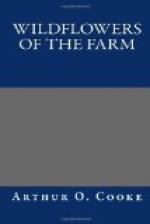Look at this Tufted Hair Grass. It is very pretty, perhaps one of the prettiest grasses we have seen; but the farmer looks upon it as a weed. It has a large and spreading head of flower; the spikelets grow on stems, and become gradually smaller towards the top of the stalk. The flower is purple, with a shining silvery light upon it. It grows in thick clumps or tussocks, and cattle do not care about the leaves.
CHAPTER VIII
IN THE HAY-FIELD (continued)
There are many other grasses in the field; some of them are useful, while others the farmer would call weeds. We must now look at other flowers, and, as the grass is so tall, it will be better to choose tall flowers which can easily be seen. We soon spy a Thistle among the grass near the gate.
There are several kinds of Thistle in England—the Milk Thistle, the Nodding Thistle, and some others. This is the common Field Thistle. It is far too common to please Mr. Hammond or any other careful farmer. It is true that it is only an annual; but, like the Dandelion, it has a pappus attached to its seed. However hard Mr. Hammond tries to get rid of thistles from his fields, fresh seeds are constantly blown into them from thistles on the road-side banks, or in the fields of farmers not so careful as himself. It is very disheartening to a good farmer to have careless neighbours. When Mr. Hammond hears that a new tenant is coming to a neighbouring farm, he always hopes that he will be a “clean” farmer—that he will try to keep his fields free from weeds.
The stiff stem of the Thistle is often three or four feet tall, and divides into smaller branches which bear a flower at the end. These flowers are a little like those of the Red Clover; each blossom has many small upright florets, purplish-red in colour. The leaves are not very tempting to touch, but they are very interesting. They are divided into several lobes or divisions, and each lobe ends in a sharp point. They have no leaf stem to connect them with the stalk of the plant. What is curious about them is that they do not grow from a small point on the stalk. They are “decurrent,” or running along the stalk; a broad strip at the base of each leaf is attached to the stalk.
Docks too are far too numerous among the grass. They are very troublesome weeds; they are perennials, and they also scatter a great deal of seed. They have large clusters of small flowers without any true petals. The leaves are very large and pointed, growing on long leaf stems. The stems of the Dock are tough, and they blunt the mowers’ scythes and the knives of the mowing-machine.
Some people have a good word even for the Dock. They say that a Dock leaf wrapped round the part stung by a nettle will lessen the pain; others advise us to rub the part with Dock seed. I do not think myself that either remedy has much effect; but the leaves of the Sorrel, which is a relative of the Dock, will lessen the pain of nettle stings. Mrs. Hammond always uses Dock leaves to wrap round the pats of butter which she sends to market.




